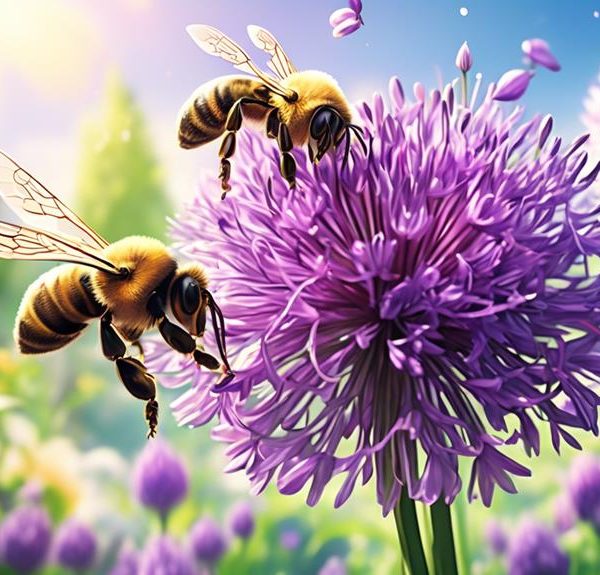Learn why bees favor certain flowers over others and discover how to make your garden a bee paradise.
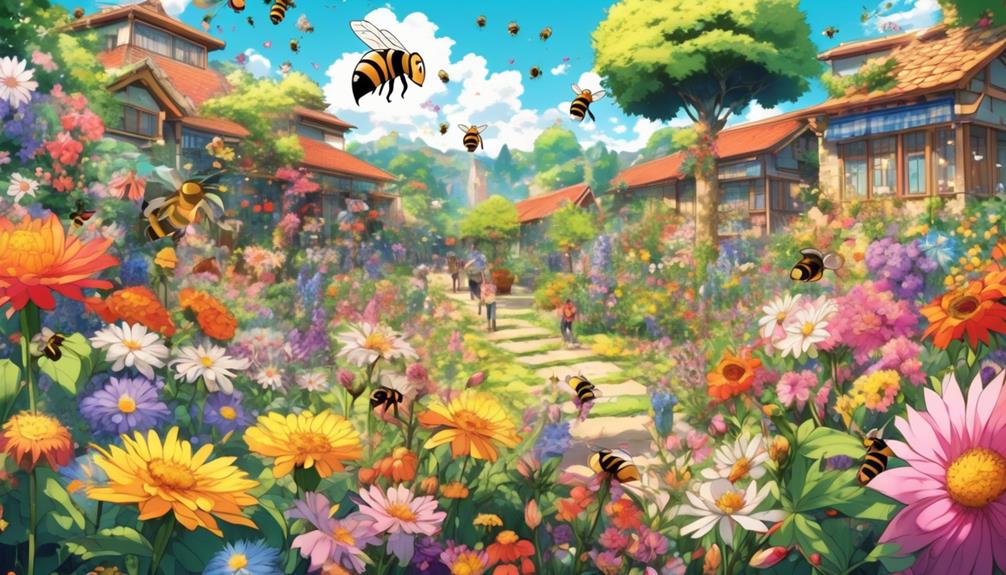
Do Bees Like All Flowers?
In the bustling city, you're more likely to spot a taxi than a tulip, yet in the quiet countryside, the bees are spoiled for choice.
You've probably noticed that these industrious insects seem to flutter around particular flowers in your garden while completely ignoring others. But have you ever wondered why? Is it merely a matter of preference or is there more to this selective behavior than meets the eye?
Let's venture into the fascinating world of bees and their relationship with flowers, and who knows, you might just uncover some secrets to make your garden a bee haven.
Key Takeaways
- Bees are selective in their flower visits based on color, shape, and scent.
- Bees are drawn to blue, purple, and yellow flowers due to their color vision.
- Bees prefer flowers with flat or shallow blossoms for easy access to nectar.
- Scent plays a significant role in attracting bees, with specific fragrances favored by them.
Understanding Bee's Pollination Behavior
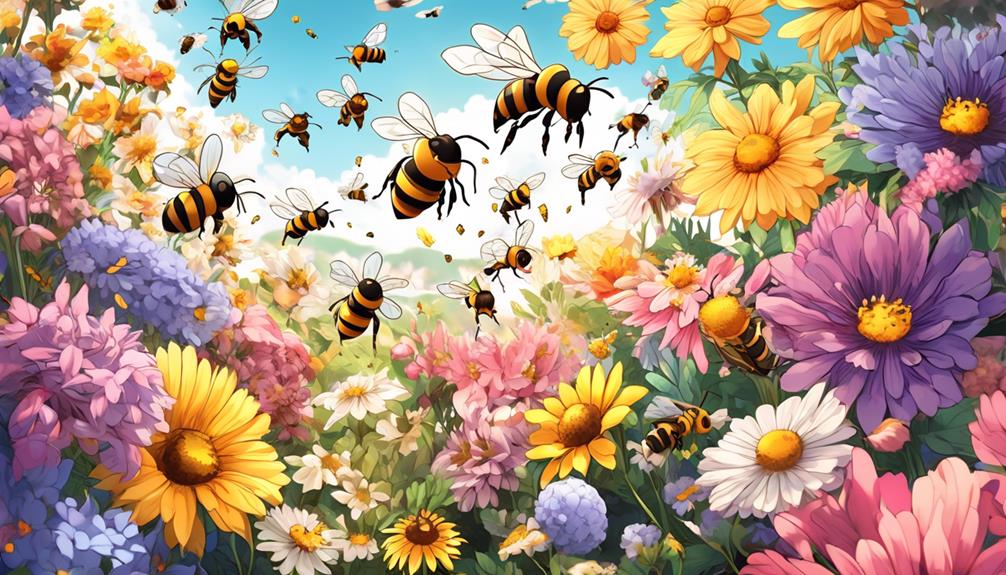
Delving into the world of bees, you'll observe their complex pollination behavior, which is driven by intricate interactions with various flower species. Bees don't indiscriminately visit all blooms; instead, they're selective, guided by the flower's color, shape, and scent. Bees have an affinity for blue, purple, and yellow flowers, and their vision spectrum doesn't include red. So, red flowers aren't typically their first choice unless they exhibit ultraviolet patterns that bees can detect.
You'll also note that bees prefer flowers with a flat or shallow blossom. Such designs provide easy access to the nectar and pollen, saving them energy. Interestingly, certain flower species have evolved to attract specific bee species. The bee orchid, for instance, has adapted to mimic the appearance and scent of a female bee to lure males for pollination.
Analyzing bees' scent preferences, you'll find that they're attracted to sweet, fresh, and slightly fruity scents. They tend to avoid flowers with strong, fetid smells. Understanding these subtle preferences helps in appreciating the intricate dynamics between bees and flowers, a relationship that's critical for our ecosystem's survival.
Factors Affecting Bees' Flower Selection
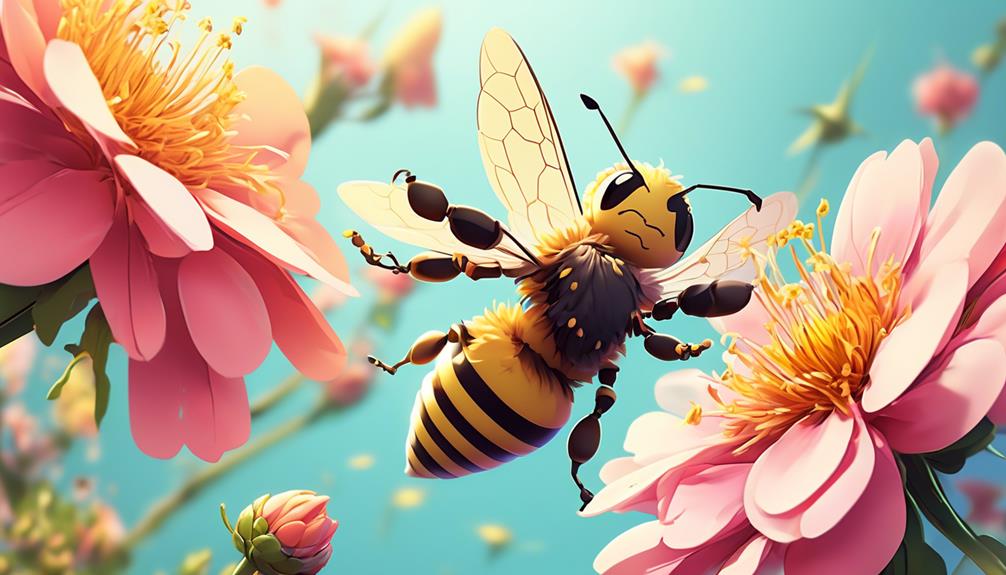
While it's clear that bees exhibit preferences in their flower selection, several factors influence this decision, including the flower's color, shape, scent, and nectar availability.
You see, bees have color vision, which they use to locate flowers and other sources of food. They're particularly drawn to blue, purple, and yellow flowers.
The shape of the flower also matters. Bees prefer flowers with flat or shallow blossoms, such as daisies or sunflowers, because they can easily access the nectar. Flowers with complex shapes or deep centers are often less attractive to bees.
Scent plays a crucial role too. Bees have an acute sense of smell, and they're attracted to sweet, strong scents. So, flowers that emit strong fragrances, especially in the morning, are more likely to attract bees.
Lastly, nectar availability is a major determinant. Nectar is bees' primary source of energy. Therefore, flowers that produce abundant nectar will attract more bees. It's a clear case of supply meeting demand.
Favorite Flowers of Bees

Given these factors that influence bees' attraction to flowers, let's now explore some of their top favorites, the ones they're naturally inclined to visit most frequently.
Among their favorites are Asteraceae, a family of flowering plants that includes sunflowers, asters, and daisies. These plants are nectar-rich and have a flat surface that makes it easy for bees to land.
You'll also find bees buzzing around Lamiaceae, a family that includes mint, sage, and rosemary. These plants emit a strong scent that attracts bees and offers a hefty supply of nectar and pollen.
Fabaceae is another preferred family with flowers like peas, beans, and clovers. These plants provide bees with a high-protein pollen that's essential for the bees' diet.
But it's not just about the flower's family. Color also plays a crucial role. Bees are especially attracted to blue, purple, and yellow flowers. Bees can't see red, but they do see ultraviolet, a color invisible to the human eye.
This combination of factors: flower family, nectar, pollen, scent, and color, contributes to a bee's flower preference. So, while bees don't like all flowers, there are certainly a few they favor.
Flowers Bees Generally Avoid
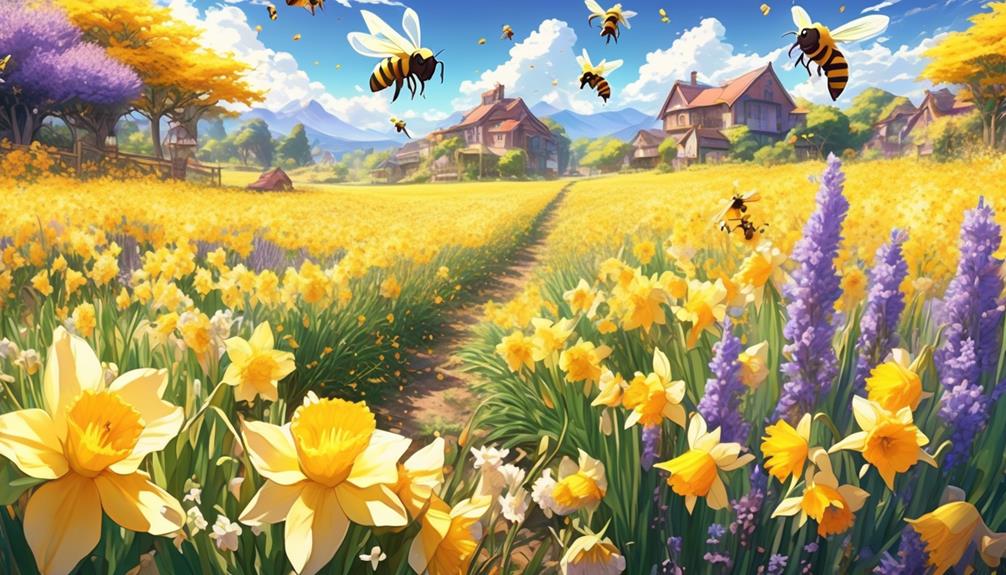
On the flip side, there are certain flowers that bees tend to avoid due to factors such as their scent, color, or lack of nectar and pollen. Despite their vibrant colors, geraniums and petunias are generally not favored by bees. They're not inherently repellent to bees, but they're low on the list of preferences due to their scarce nectar production.
Flowers with complex structures, like double-bloom varieties of roses or peonies, are also less attractive to bees. The intricate layers of petals make it difficult for bees to access the nectar and pollen.
Here's a simple table detailing some flowers that bees generally avoid:
Flower | Reason for Avoidance |
|---|---|
Geranium | Low Nectar Production |
Petunia | Low Nectar Production |
Double-Bloom Roses | Complex Structure |
Peonies | Complex Structure |
You might be wondering why it matters which flowers bees avoid. Well, understanding their preferences can help us create bee-friendly environments and ensure the survival of these vital pollinators. So, while it's true that not all flowers are loved by bees, we can choose to grow those that are.
Impact of Color and Scent on Bee Attraction
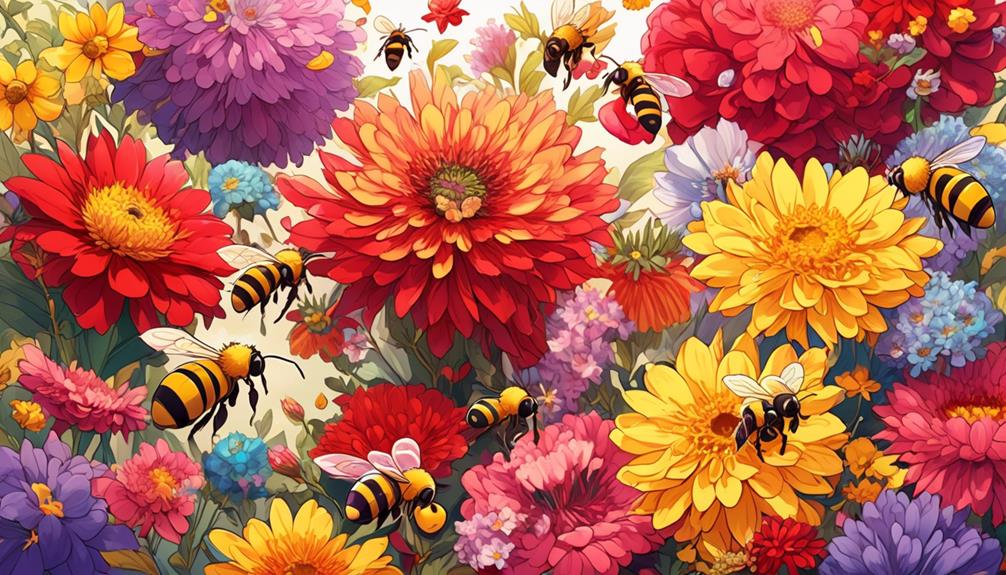
Shifting our focus from the flowers bees tend to avoid, let's consider how color and scent play a significant role in attracting these vital pollinators. Bees aren't just attracted to any flower; they're highly selective, with color and scent being the chief determinants.
Bees, unlike humans, see color differently. They can't see red but can perceive ultraviolet light which we can't. This ability enables them to detect patterns on flowers' petals, guiding them to the nectar. Blue, purple, and yellow flowers are particularly attractive to bees, as they stand out in the UV spectrum.
Scent is equally important. Flowers emit specific volatile compounds that bees can detect from a distance. This floral aroma serves as a signal, leading bees directly to the nectar source. Certain fragrances such as those emitted by lavender, mint, and sunflowers are greatly favored by bees, enhancing their pollination efficiency.
However, it's not just about a single flower's color or scent. Bees are more likely to visit flower patches of a single species, attracted by the combined visual and olfactory cues. This 'flower constancy' is nature's way of ensuring effective cross-pollination.
Enhancing Your Garden for Bees
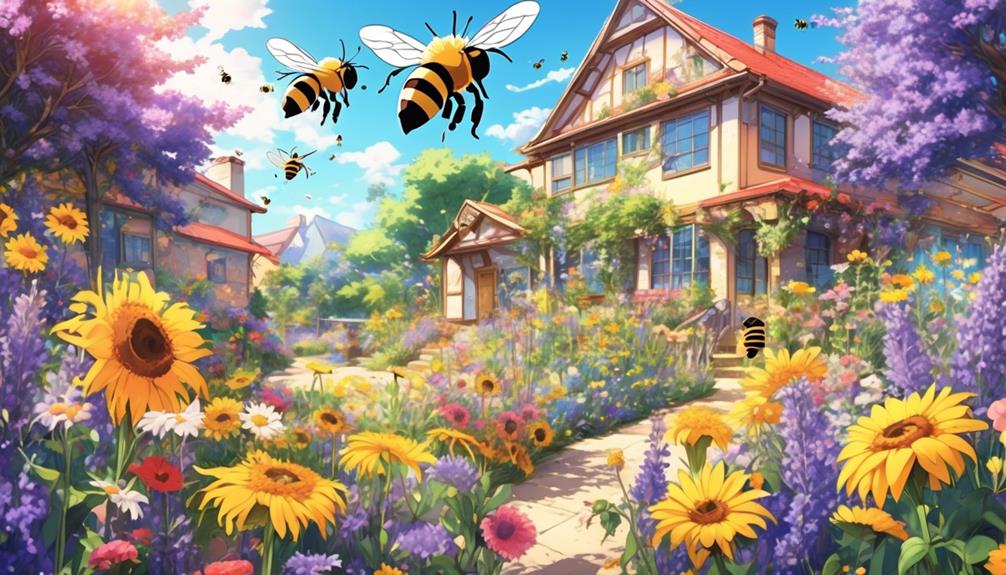
To make your garden a haven for bees, you'll need to consider specific plant choices, garden features, and cultivation practices that cater to these pollinators' preferences.
Your plant choices should be diverse, with a focus on native species. Bees favor a variety of flowers that bloom sequentially, ensuring a steady supply of nectar and pollen throughout the growing season. Local, native plants are typically better suited to your area's climate, soil, and local bee species.
Incorporating garden features that provide bees with nesting and overwintering sites is also crucial. Leaf litter, deadwood, and bare ground offer suitable habitats for many native bees. You can also install bee hotels, which are often favored by solitary bees.
Your cultivation practices should aim to minimize disturbance. Avoid pesticides, as these can be harmful or lethal to bees. Instead, manage pests through natural methods such as biological controls and crop rotation. Regular watering is also important, as it helps plants produce nectar.
Lastly, consider the structure of your garden. Layered vegetation, with ground covers, shrubs, and trees, mimics a natural environment and provides diverse foraging and nesting opportunities for bees.
Frequently Asked Questions
What Happens if Bees Become Extinct?
If bees become extinct, you'd see a dramatic impact on the environment. They're key pollinators, so without them, many plants wouldn't reproduce.
You'd notice fewer flowers, fruits, and vegetables. This would disrupt the food chain, affecting animals that rely on these plants for food.
Plus, humans would face a food crisis and economic issues due to the loss of crops.
How Do Bees Communicate With Each Other in a Hive?
You're curious how bees communicate in a hive, aren't you? They use a method called the 'waggle dance.'
When a worker bee finds a rich food source, she'll return to the hive and perform a series of movements to show its location.
The angle of the dance indicates the direction, while the duration suggests the distance.
It's an intricate language and shows just how complex these little creatures are!
Are Bees Endangered and What Are the Main Threats to Their Population?
Yes, bees are endangered, with multiple threats contributing to their decline. You've got habitat loss, pesticides, disease, and climate change all posing significant challenges.
When you destroy their natural homes, you're taking away their food sources. Pesticides, especially neonicotinoids, are incredibly toxic to bees. Diseases like Colony Collapse Disorder decimate hives.
And let's not forget climate change, which disrupts the timing of flower blooming, affecting bees' food supply.
Apart From Flowers, What Other Sources of Food Do Bees Have?
Bees don't just rely on flowers for food. They also consume tree sap, fruits, and even the sugary secretions of other insects known as 'honeydew'. Their diet isn't as limited as you might think.
In times of scarcity, bees will even raid other hives for honey. Yet, it's important to note that a balanced diet of nectar and pollen from a variety of flowers is vital for their health and survival.
How Do Bees Produce Honey and What Role Do Flowers Play in This Process?
You're curious about how bees produce honey.
Well, bees collect nectar from flowers, which they then convert into honey in their hive.
Flowers play an essential role in this process, as they provide the nectar. The bees use their long, tube-shaped tongues to suck the nectar out of the flower and store it in their honey stomachs.
Back at the hive, they'll regurgitate and dehydrate it to create honey.
Conclusion
To conclude, bees aren't indiscriminate; they've discerning tastes and preferences when it comes to flowers. Factors like flower type, color, and scent significantly influence their choice.
While they're drawn to flowers like sunflowers and lavender, they often avoid others like tulips. Understanding this can help you optimize your garden for these vital pollinators.
Remember, supporting our buzzing friends supports the health of our ecosystem.


